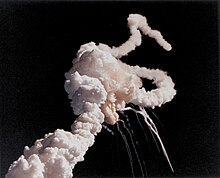Challenger (space shuttle)



The space shuttle Challenger ( English for challenger ) was a NASA space shuttle that completed ten space flights between April 1983 and January 1986. Its internal name was OV-099. Originally built as a platform for ground tests, it was later converted for use in space. In the Challenger disaster on January 28, 1986, the space shuttle exploded shortly after take-off, killing its crew.
history
The Challenger was taken into active service by NASA as the third space shuttle orbiter (after the prototype Enterprise and the first fully operational space shuttle orbiter Columbia ). The spaceship was named after the British research ship HMS Challenger , which sailed the oceans from 1872 to 1876. The lunar module of Apollo 17 was the name.
In February 1972, the aerospace company Rockwell International (now part of Boeing ) received the order to build initially two space shuttle orbiters, Enterprise and Challenger , both of which were intended for ground tests and not yet for use in space .
Use for soil tests
As a test orbiter designed for the shuttle program, which was Challenger after its completion in May 1977, first for nearly a year under the internal designation STA-099 ( STA represents S tructural T est A rticle ) for vibration tests.
Starting in 1979, the Challenger was subsequently expanded to a full-fledged space shuttle capable of space flight instead of the Enterprise (the first structural test article with which drop and landing tests were carried out). Completed for use in space in October 1982, the Challenger was also given the new internal designation OV-099 .
Use in flight operations
The Challenger's maiden flight took place in April 1983 ( STS-6 ). She undertook a total of nine complete space flights (three each in 1983, 1984 and 1985), with a total of 69 days in space and 987 orbits of the earth.
On January 28, 1986, 73 seconds after the start of the STS-51-L mission , the space shuttle exploded at an altitude of about 15 kilometers (see Challenger disaster ). All seven astronauts died. The reason found was the failure of one or more sealing rings in one of the solid rockets on the side . It was the worst accident in US space history to date .
Missions
Whereabouts
The wreckage of the Challenger recovered after the explosion is now stored in a former missile silo in Launch Complex 31 of Cape Canaveral Air Force Station .
media
Numerous television documentaries and several feature films were dedicated to the Challenger disaster.
In 2013 the feature film The Challenger was released, which deals with the investigation of the accident.
Web links
- Raumfahrer.net: The Orbiter Challenger (OV-099)
- NASA: Description and flights of the Challenger (English)
- NASASpaceflight.com: Chronicle of the space shuttle Challenger (English)
Individual evidence
- ↑ Martin Holland: 30 years of the Challenger disaster: the first major catastrophe in US space travel. In: heise online . January 28, 2016, accessed December 10, 2019 .
